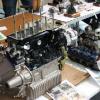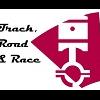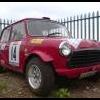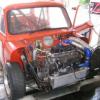
How To Reduce Transmission Power Losses?
#1

Posted 27 August 2012 - 12:24 AM
iv just had my 998 with a stage 1, electronic ignition, and no wax stat tuned.
it had 50.9bhp and roughly 32 at the wheels.
im just wondering as i know minis aren't all that sophisticated and efficient but that seems like a lot of power loss through the transmission, is this normal ? are there anyways of reducing this?
#2

Posted 27 August 2012 - 12:39 AM
The other way is to get rid of the idler gear, which is probably the lossiest gear in the drive train, as it has complex lateral loading, which as you will know, can wear its thrust washers quite rapidly. A chain drive would be better, if you could find a suitable chain and sprockets, or turn the engine round and use two larger gears without the idler, as per original design. Lots of complex machining and maybe new castings in either case. You could maybe gain 4 bhp.
Split sumping, with an oil tray between engine and gearbox, and various other mods to get segregation, would allow you to use a thinner oil in the gearbox, so less loss. Some modern manual transmissions use automatic transmission fluid for that reason. Again. lots of complicated machining, not as much as changing the idler, and maybe 2 bhp max gain.
It would be far easier to transplant a complete modern engine and transmission.
#3

Posted 27 August 2012 - 07:48 AM
Just give your engine and gearbox a refurb? If it hasnt been done recently then it is likely some of the bearings and other components have worn. Replacing these could help freshen up your gearbox.
I know my 998 stage 1 when I had it on smart performance's rollers was 48 at the fly and 35 at the wheels, with an old gearbox, didn't get a chance to compare the rebuilt gearbox though as it has gone on my new engine.
#4

Posted 27 August 2012 - 08:03 AM
Obviously this doesn't solve the losses issue
A blueprinted gearbox may lose less power, and a blueprinted engine would produce more
#5

Posted 27 August 2012 - 08:58 AM
#6

Posted 27 August 2012 - 10:51 AM
in which case you are factoring in everything from the end of the engine through the gearbox... driveshafts, wheels, rollers, etc...
So simple things:
Tyres pressures?
Front wheel alignment? - wheels pointing in different directions will lead to more 'transmission loss'
Brakes? (binding up?)
Wheel bearings? (new bearings of late are *really* tight when assembled :s )
Never convinced of these run down losses.. some are frankly stupidly high and to be losing that much power, something should be glowing red hot as it diperses so much energy
#7

Posted 27 August 2012 - 11:04 AM
it had 50.9bhp and roughly 32 at the wheels.
the figures here dont make sence... your putting it here as if the engine power was measured and road wheel figure was the assumed/calculated figure
On a rolling road its the other way round, measured at the wheels and then calculated to give an engine figure
#8

Posted 27 August 2012 - 12:02 PM
That seems to be fairly normal. You could get an improvement by using straight cut gears, but they are not much use in a road car that you actually drive for reasonable distances, due to the noise.
The other way is to get rid of the idler gear, which is probably the lossiest gear in the drive train, as it has complex lateral loading, which as you will know, can wear its thrust washers quite rapidly. A chain drive would be better, if you could find a suitable chain and sprockets, or turn the engine round and use two larger gears without the idler, as per original design. Lots of complex machining and maybe new castings in either case. You could maybe gain 4 bhp.
Split sumping, with an oil tray between engine and gearbox, and various other mods to get segregation, would allow you to use a thinner oil in the gearbox, so less loss.
Interesting post- I'm wondering though, do you really think a chain (with scores of links each with their own joints) would be more efficient than one idler gear?
Also I have wondered myself about split sumping the engine/gearbox, but I'm sure I heard from someone that our gearboxes were originally designed to run EP90 or something like that?!
#9

Posted 27 August 2012 - 12:56 PM
I believe that some cars, not so long ago, did actually use a chain, and maybe the parts from one of these would be adaptable, or maybe a chain from a very powerful motorbike, shortened of course, if it was ok at full engine rpm.
I have also been looking at completely different gearbox configurations. Thus far, I only have a few sketches and ideas. Basically I was thinking about a very short end-on gearbox, to enable a bigger variety of engines to be used, but I am not at all sure that it can be made to work efficiently.
It may well be that electric drive will be more efficient now, with some of the latest motors and generators. On one of the project threads, someone has taken an interesting approach to that, fitting a pair of motors where the diff would be, to drive the pot joints directly. (Electric motors will always be far too heavy to mount directly on the hubs, as you don't want a lot of unsprung weight, which would ruin the handling.) He is using battery power, but you could do it with an engine, the generator replacing the clutch and flywheel. If you have a battery too, for peak power requirements, you then have a hybrid.
Oh, and as for split sumping, the gearbox was derived from the Austin A35, which would have run on some kind of oil such as EP90, but some modern gearboxes, such as Vauxhalls, do use ATF successfully in manual boxes, so it seems that it is possible to have low viscosity and good EP characteristics in the same oil. In any case, you could run with a gearbox oil pump, which sprayed a light oil mist only where needed, instead of having the entire gear set dipping in a pool of oil, as it does.
Edited by tiger99, 27 August 2012 - 01:01 PM.
#10

Posted 27 August 2012 - 02:16 PM
Am assuming here that the difference between road and flywheel were based on the dyno running down?? and so calculated the losses??
in which case you are factoring in everything from the end of the engine through the gearbox... driveshafts, wheels, rollers, etc...
So simple things:
Tyres pressures?
Front wheel alignment? - wheels pointing in different directions will lead to more 'transmission loss'
Brakes? (binding up?)
Wheel bearings? (new bearings of late are *really* tight when assembled :s )
Never convinced of these run down losses.. some are frankly stupidly high and to be losing that much power, something should be glowing red hot as it diperses so much energy
This is the key point. Forget all the stuff about changeing drops to a chain, or any of the other stuff. These are things you would consider if you were wanting to extract every last ounce of power and had an unlimited budger, not suitable advice for a boggo 998 with 50bhp.
On any rolling road it is critical that a rundown test is performed or the figure at the wheels is just a finger in the air number and not comparble to anything. When you see massivle power losses, these are generally just a % figure fudge factor; not a measured loss.
Large losses as you are seeing are as above are most likely to be related to tyre pressures, worn bearings or binding brakes. Having said that 20bhp is not a massive loss and because of the way it is measured, I wouldn't worry about it.
1 user(s) are reading this topic
0 members, 1 guests, 0 anonymous users



















